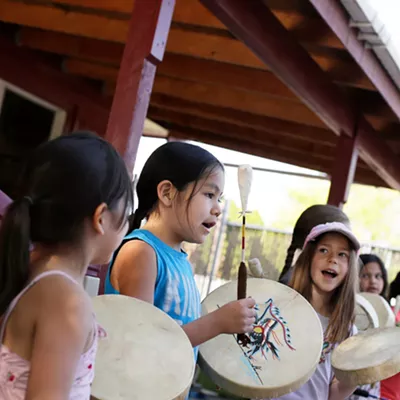Couples -- the kind that stay together for decades or an entire lifetime -- have a great perspective on sorting out difficulties. "It's not about somebody giving in or not," says Cipa Dichter, about her relationship with her husband Misha. "It's about balancing perfectly, and having conversations and discussions. I don't think you would ever talk in terms of one of us winning."
"The challenge," Misha adds, "is to adapt to each other so there's a unity of purpose."
When the Dichters talk like this, it's hard to know if they are talking about their 35-year marriage, or their career. Like many couples, the Dichters work together; but what they do is play the piano -- a particularly intimate and emotional job. On Friday -- Valentine's Day -- the Dichters will join the Spokane Symphony for an appropriately romantic concert, featuring Sergei Prokofiev's luscious ballet music for Romeo and Juliet; American composer Howard Hanson's Symphony No. 2, "Romantic"; and Mozart's famous concerto for two pianos in E-flat Major.
The Mozart, aside from being the most famous work written for two pianos and orchestra, is also a special piece for the Dichters. "It goes back 31 years now," Misha recalls. "That was a surprise that I pulled on Cipa in the summer of 1971, when she was about to give birth to our elder son. And I was playing at the Hollywood Bowl, and I had been reading a lot about postpartum depression. And I thought that in one month that might actually be the case with her, so I quietly arranged that the next year we would be playing the Mozart at the Hollywood Bowl, and I called her up and told her what was happening. And it got her quite past the thought of childbirth."
There is a silence from Cipa after her husband finishes the story, and then she laughs. "I wonder which is harder!"
"I think childbirth," Misha says, after a beat.
That ability to think together, along with their shared sense of humor, has served the Dichters well during their concert career with the concerto. Alongside Mozart's famous warmth and energy is a special sense of cooperation and interplay. The two pianists are often creating a single musical texture from the instruments, but at the same time, the musical writing plays with who is in charge of creating what effect. For an audience hearing a sensitive performance, this spirit of humorous collaboration is palpable -- much more so than in even an ordinary concerto, where one soloist interacts with the orchestra.
"That's always the interesting part of our rehearsals," Misha explains, about the way that two-piano music often uses the musicians for different roles. "You immediately learn which voices are less important. It might feel unnatural, because when playing solo piano, the right hand is usually the singing voice. But with four hands, the right hand might have the middle register -- what would be the viola register in a string quartet. And one immediately adjusts the sound to keep out of the way of the more important voices. So the sorting out can be done in quite an unspoken way, just listening like crazy and adjusting as it happens."
Nevertheless, working together on a piece of music isn't a completely unconscious endeavor for the Dichters, even after decades of experience. They still maintain separate practice rooms in their New York apartment, separated by what Misha calls "double James Bond-ian doors -- completely soundproofed." And when they get together at the two pianos in their living room to practice, they pay close attention to a particular difficulty of playing a single piece of music on two pianos: coordination. While all music that an ensemble plays requires careful synchronization, the percussive nature of the piano makes any difference in the timing of the playing painfully apparent.
"There's nothing more annoying than hearing the clunk of two pianists trying to play a chord together," Misha says wryly. "So the synchronization -- while it's become almost second nature to us -- we are still conscious of the fact that we do have to breathe together and think together."
Add the orchestra members trying to do the same thing with each other and their visiting soloists and conductor, and you start to get an idea of the intimate collaboration that goes on when music is performed. Even if you don't fall in love during the process, something is bound to result.
"Playing together," says Misha laughing about how he and his wife started their collaboration, "was just a natural outgrowth of what students at Julliard did at the end of a 12-hour practice day. Which was to get together and play some more piano -- four hand."
Publication date: 02/13/03














